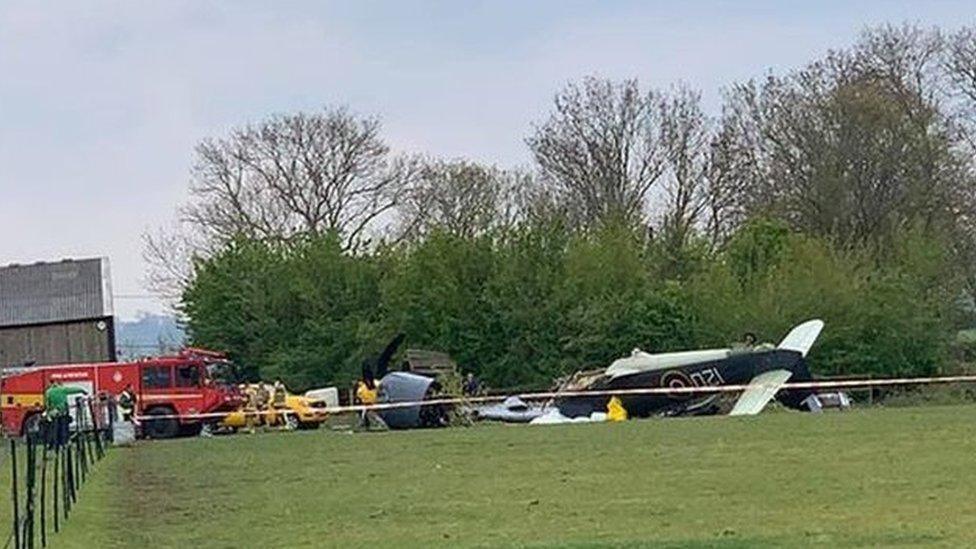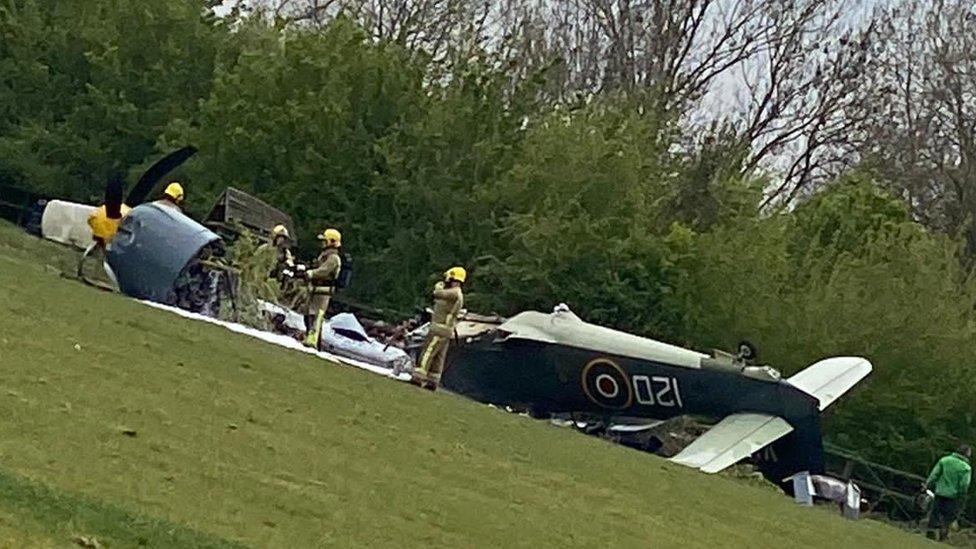Historic fighter plane narrowly missed house before crash
- Published

The Hawker Sea Fury T.20 crashed close to Royal Naval Air Station Yeovilton in April
A historic fighter plane missed the roof of a house by just six metres before crashing into the ground, a report has found.
The air accident report, external into the incident at Yeovilton in Somerset in April 2021 found the aircraft crashed 10 seconds after its engine seized.
The pilot and his passenger were able to scramble clear of the wreckage.
Both were wearing "full military-style flying kit and helmets", which prevented "much more serious injury".
The report was complied by the Air Accident Investigation Branch and published on Thursday.
It said the 1949 Hawker Sea Fury aircraft had been on a training flight, following a long period of storage, when the crash happened at 13:15 BST on 28 April.
The two men onboard, who were described as having "extensive 'warbird' experience", were both taken to Yeovil Hospital as a precaution.

The pilot and his passenger were able to escape without serious injury despite the aircraft landing upside down
The aircraft was being positioned for a landing at RNAS Yeovilton after the 60-year-old pilot, who had 11,550 hours of flying experience of which 36 hours were in the Sea Fury, noted low engine oil pressure.
He informed the airfield's air traffic control and turned back towards the airfield but described the engine is as "lumpy and unsteady", according to the report.
The report said the engine generated several "violent thumps" before it seized.
The pilot made a mayday call before the plane hit the ground half a mile from the runway, where it broke into several sections.
"The aircraft initially struck a telegraph pole, having cleared the roof of a nearby house by approximately six metres, before it then struck the ground in a level attitude in an area of paddocks," the report said.
The aircraft slid across the surface of the paddock before striking a hedge, leaving a 95-metre trail of wreckage.

The length of the wreckage trail was 95 metres
The report concluded that the point at which the engine seized left "the pilot was left with no choice but to attempt a forced landing short of the runway".
"There is no way to predict what caused the final failure," it added.
"The time between the engine failure and the aircraft striking the ground was around 10 seconds."
Examination of the pilot's helmet after the accident showed that it had suffered a "significant blow".
Although the pilot suffered a small fracture to the skull, the helmet had protected him from a much more serious head injury, the report said.
"The fact that both occupants were wearing helmets almost certainly saved them from any serious head injuries despite the cockpit coming to rest almost inverted," it added.
The investigation identified the difficulty maintenance organisations have in accessing technical information for historic engines, in particular that relating to engine modifications.
The Civil Aviation Authority have agreed to meet with the engine manufacturer to discuss improvements.

Follow BBC West on Facebook, external, Twitter, external and Instagram, external. Send your story ideas to: bristol@bbc.co.uk , external
- Published28 April 2021

- Published29 April 2021
